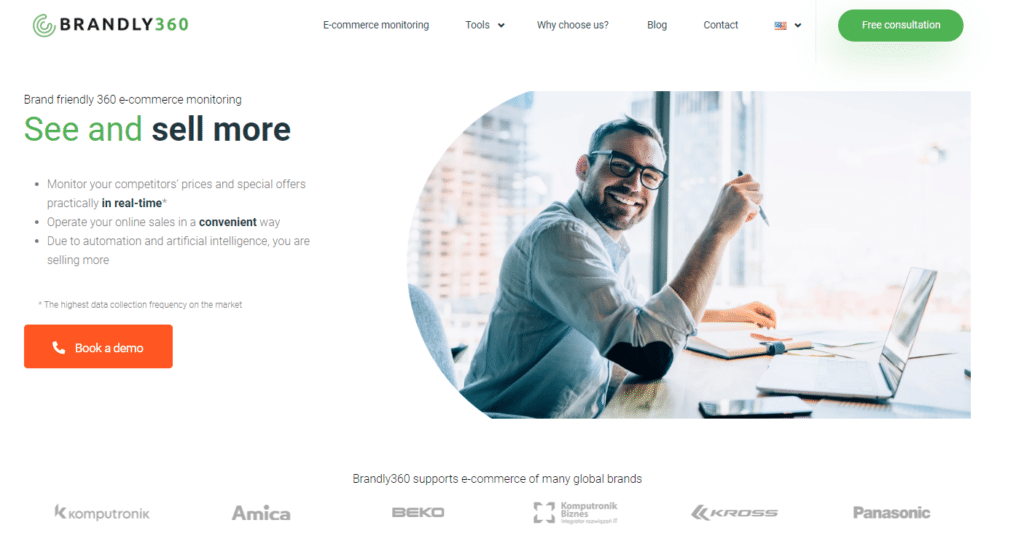In the ever-evolving world of retail, who doesn’t love a good deal? With customers becoming increasingly demanding when it comes to finding the best possible value for their money and with the explosion of online shopping, stores are finding it necessary to offer more competitive pricing. One of the most widely adopted strategies to do this is price matching.
Here’s a quick primer on price matching to help you make your pricing strategy more competitive. We’ll explain the concept in detail, delving into the how, why, when, and where of price matching. By the end of this article, you should know everything there is to know about this fascinating concept.
Key Takeaways
- Price matching is a popular marketing strategy used by retailers to ensure their customers receive the best value for their money.
- There are various types of price matching strategies, including standard price matching, pre-sale and post-sale price matching, and price beating.
- Implementing a price-matching policy can enhance customer loyalty, attract new customers, maintain market share, and improve brand reputation.
- Price matching has a number of potential drawbacks, such as the risk of degrading margins, price wars, or losing customers in the long run if the strategy cannot be sustained.
- The price matching strategy is widely used among giant retailers, including but not limited to Best Buy, Media Markt, or Target.

source: https://pl.freepik.com/darmowe-wektory/popyt-analitycy-sciskaja-dlonie-z-ekranow-laptopow-i-planuja-przyszly-popyt-planowanie-popytu-analiza-popytu-ilustracja-koncepcji-prognoz-sprzedazy-cyfrowej_11668571.htm
What Is Price Matching?
Price matching, also known as price guarantee, is a marketing strategy employed by retailers to ensure that their customers receive the best possible value for their money. This concept involves equalizing the price of your product to the most competitive offer currently available in the market.
To illustrate the point, let’s assume your online store sells CBD oil for $40 per bottle. However, a customer finds that one of your rivals is selling the same product for $35. If you decide to price match, you would lower the price of your product to $35 as well.
The idea here is that consumers always prefer to save money when buying goods from a retail store and will most likely be attracted to offers with the lowest price tag. By doing the price match, you are essentially nullifying the cost advantage that your rival has over you, making it much more likely that the consumer will purchase from your store instead.
Want to get set up with competitor monitoring, price tracking and even more?
Book a free demo to monitor any e-commerce competitor pricing and get instant info of important price movements and more!
Price Matching Works Best With e-Commerce Monitoring Tools
To effectively price match, you need to have real-time knowledge of the pricing strategies that your competitors are using. Although it is theoretically possible to keep an eye on the online prices of your competitors manually, it would require a team of dedicated professionals who are always scouring the Internet for updates. In practical terms, this is very inefficient and prohibitively expensive.
The best way to track the online prices of your competitors is to use a dedicated e-commerce monitoring solution like Brandly360.
For a fraction of what it would cost to hire a team of professionals, you can use Brandly360’s live price monitoring tool to track your competitors’ pricing strategies in almost real-time (the data is collected every 10 minutes), simplify price matching, and ensure that you are always offering the best possible value for your customers.
Comprehensive price tracking is just one of the many features that Brandly360 offers. Are you experiencing issues with product descriptions across different retailers? Would you like to monitor your promotions and sales in detail? Are you interested in collecting feedback about your products or services to help you make your business even more competitive?
All that and more is easily possible if you decide to use Brandly360. With affordable subscription plans and a wide range of useful features, Brandly360 will help you level up your e-commerce game in no time!

source: https://pl.freepik.com/darmowe-wektory/centrum-danych-mediow-spolecznosciowych-statystyki-smm-cyfrowe-badania-marketingowe-analiza-trendow-rynkowych-ekspertka-badajaca-wyniki-ankiet-online_11669180.htm
Types of Price Matching Strategies
There are several types of price-matching strategies that retailers can adopt, depending on their specific needs and objectives. Let’s take a closer look at some of the most common approaches:
| Strategy | How does It work? | How does it help? |
| Standard Price Matching | Business A sets the same low price for a product as business B. | Helps negate the price advantages of rivals in the niche. |
| Pre-sale Price Matching | Based on the evidence, business A matches the price set by business B before the customer makes a purchase. | Helps convince customers to buy from business A instead of waiting for a future sale. |
| Post-sale Price Matching | Based on the evidence, business A refunds the difference in cost to the customer if the product can be bought from business B. | Boosts customer loyalty and promotes repeat business. |
| Price Beating | Business A sets the price of a product slightly lower than the already-reduced price from business B. | Helps attract budget-conscious consumers. |
Standard Price Matching Policy
This is the most straightforward form of price matching, where a retailer agrees to match a competitor’s lower price on an identical product.
The customer typically needs to provide proof of the competitor’s pricing, such as a printed advertisement or screenshot from an online store.
Pre-sale Price Matching Policy
In this scenario, a retailer offers to match a competitor’s lower price before a purchase has been made.
This proactive approach can help attract customers shopping around for the best deal and may encourage them to buy from your store instead of waiting for a sale elsewhere.
Post-sale Price Matching Policy
With post-sale price matching, a retailer agrees to refund the difference in price if a customer finds a lower price on an identical product within a specified period after making a purchase.
This strategy helps build trust with your customers and encourages repeat business by demonstrating your pro-consumer values.
Price Beating Policy
Having a price match policy puts you on even ground with the competition. Naturally, some retailers want to go a step further to attract the consumer.
This practice is known as price beating, and it involves offering a lower price on an identical product, even if the competitor’s price is already very competitive.
In these cases, the retailer might offer a discount of 5% or 10% off the competitor’s lower price. This aggressive approach to price adjustment can help attract bargain hunters who are always looking for the best possible deal.
Bear in mind that price beating can be a double-edged sword. While it’s true that offering a significantly lower price than the competition can help increase sales in the short term, it might also erode your profits and damage your brand image in the long term if not done correctly.
Because of that, it’s best to limit price beating to specific promotions or periods when you are confident that you can still turn a large profit.

Want to get set up with competitor monitoring, price tracking and even more?
Book a free demo to monitor any e-commerce competitor pricing and get instant info of important price movements and more!
Why It’s Worth Implementing Price Matching?
There are several compelling reasons for retailers to implement a price-matching policy, including but not limited to:
- You may enhance customer loyalty: A price match policy demonstrates your commitment to providing customers with the best possible value, which can help foster long-term relationships and build trust.
- You can attract new customers: By offering competitive prices, you can draw in new customers who may have otherwise chosen to shop with a competitor. This can help expand your customer base and increase overall sales.
- You might maintain your market share: Implementing a price match policy can prevent customers from taking their business elsewhere, helping you maintain or even grow your market share in the face of aggressive competition.
- You will improve brand reputation: A well-executed price match policy can enhance your brand’s reputation by showing that you care about your customers’ needs and are willing to go the extra mile to ensure their satisfaction.
Are There Major Disadvantages of Price Matching?
Price matching is not without its challenges, and several potential drawbacks might make this strategy less than ideal for your business.
Risk of Degrading Margins/Price Wars
First of all, engaging in price matching long-term might significantly degrade your margins and put downward pressure on your prices, which could hurt your profitability in the long run.
The price of a product isn’t simply a tag with a number on it – it is the compounded cost of resources and manpower used to develop, produce, and market this commodity. You can lower the price momentarily, but doing so all the time may be unsustainable.
Because of that, the price match approach isn’t the best solution when trying to compete with giant retailers who can sell at a loss for an extended period.
You shouldn’t let your price match approach draw you into a ‘price war’ – a situation where two or more companies attempt to gain market share by offering ever-lower prices. This may lead to a race to the bottom and potentially even bankrupt you if not done correctly.
Possibility of Losing Customers in the Future
As we explained above, price-matching policies can offer amazing value for consumers, but they might be unsustainable in the long run. Unfortunately, customers often don’t realize that.
As consumers are exposed to incredible deals, their expectations will continue to rise. They might start to assume that the current low prices are the new norm and become frustrated when they realize that this is a temporary situation.
This could make them feel cheated and may even damage your brand image in their eyes, leading them to take their business elsewhere in the future.
This is especially risky to businesses that are just starting out, as such organizations don’t have a large budget to consistently match the prices of their giant rivals.
Again, don’t engage in prolonged price wars with giants like Amazon or Walmart. You can’t win, and the only thing you’ll achieve is letting your clients down when it turns out that you can’t maintain such low prices in the future.

source: https://pl.freepik.com/darmowe-wektory/sezonowe-rabaty-sprzedazy-prezenty-zakupowe-odwiedzanie-butikow-luksusowe-zakupy-kupony-promocyjne-na-obnizki-cen-specjalne-oferty-wakacyjne-ilustracja-wektorowa-na-bialym-tle-koncepcja-metafora_12083346.htm
Industry Examples
To give you a taste of how price matching can be used in the real world, we’ve compiled a few examples from different industries.
In this section, we will explore a few examples of well-known companies that offer price-matching policies in their respective industries.
1. Best Buy
Electronics retail giant Best Buy is known for its price match guarantee, which promises to keep the prices equal to local competitors and retailers like Amazon, Dell, or HP.
Naturally, Best Buy’s price match approach has limitations. Best Buy doesn’t price match items purchased from third-party sellers or websites and specifically excludes contract mobile phones, service prices, Black Friday doorbusters, and special daily sales from its policy, among other things.
2. Media Markt
As one of the premier consumer electronics retailers in Europe, Media Markt has a very aggressive price match policy. The company promises to equal the prices of major online retailers in the area in the case of both pre-sale and post-sale purchases.
3. Target
Target’s price match guarantee is very generous, offering to match the prices of products from more than 25 online retailers, including Amazon, Sears, Costco, Gamestop, and Kmart. The company also promises to refund the difference in price if a customer finds a lower price within 14 days of making a purchase.
Of course, these are only three examples of how major retail companies utilize price matching to stay competitive in their respective industries. To give you a more complete picture, below, we’ve compiled a list of other companies that have implemented price match policies.
| Retailer | Price matching target | Adjustment period | Policy highlights |
| IKEA | IKEA.com and other IKEA stores | 90 days | You need to use your IKEA Family card during purchases to be eligible for price matching. |
| Sears | Local and online competitors | 30 days | Price matching doesn’t take delivery costs into account. |
| JCPenney | Local and online competitors | 14 days | JCPenney not only matches rival prices but also beats them by 5%. |
| Kohl’s | Kohls.com and rival in-store prices | 14 days | Price matching doesn’t take into consideration online prices from Kohl’s rivals. |
| Nordstrom | Competitors from the US | 14 days | Price matching policy excludes regional or outlet stores/websites. Price adjustments are limited to cases where Nordstrom has permanently reduced the price of a product. |
Final Thoughts
Implementing a dedicated price match policy can be a powerful tool in your retail arsenal, helping you stay competitive and attract a wider customer base.
By understanding the various types of price-matching policies and their potential benefits and drawbacks, you can make informed decisions about whether or not to implement this approach in your own business.
Remember, the key to successful price matching lies in finding the right balance between offering the best value for your customers and maintaining sustainable profit margins.
As long as you can do that, price matching can help you take your business to the next level! And don’t forget to check out Brandly360 – contact us now and use Brandly360 to leave your competitors in the dust!
Want to get set up with competitor monitoring, price tracking and even more?
Book a free demo to monitor any e-commerce competitor pricing and get instant info of important price movements and more!

Manager with experience in leading team of software developers and testers during implementation of internal and external IT projects. Ceo of Brandly360.com.


